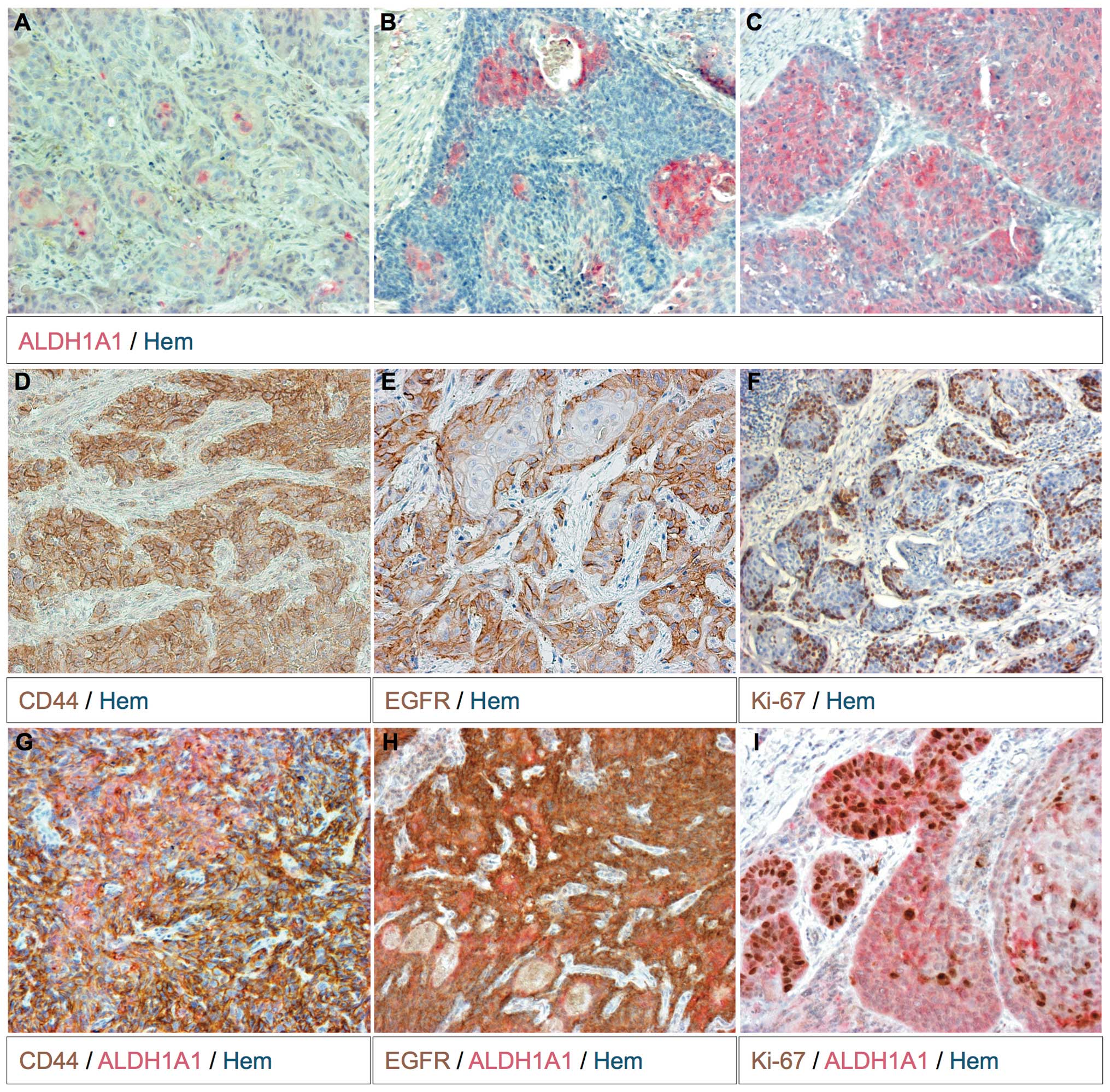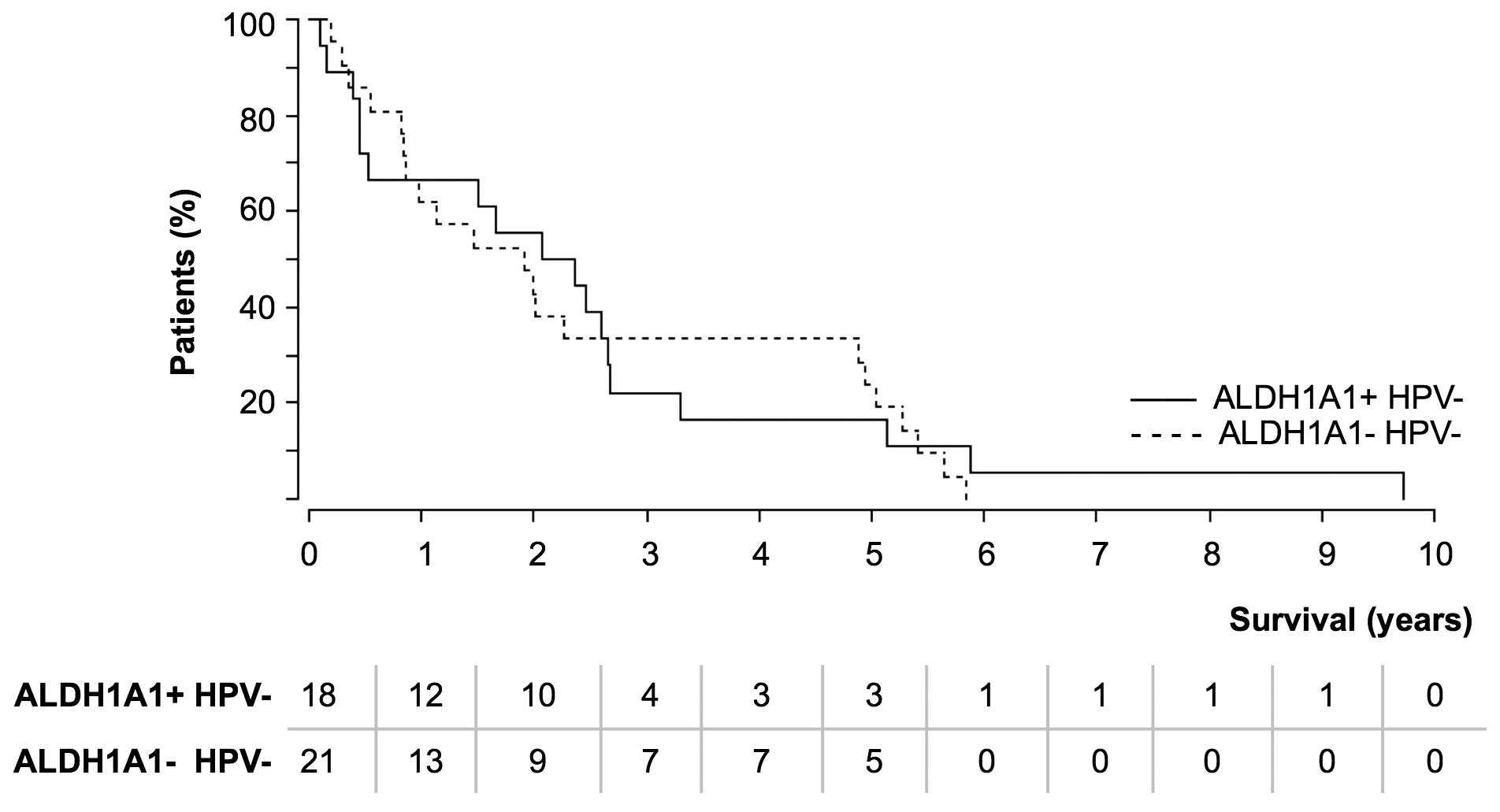|
1
|
Leemans CR, Braakhuis BJ and Brakenhoff
RH: The molecular biology of head and neck cancer. Nat Rev Cancer.
11:9–22. 2011. View
Article : Google Scholar : PubMed/NCBI
|
|
2
|
Ferlay J, Soerjomataram I, Ervik M,
Dikshit R, Eser S, Mathers C, Rebelo M, Parkin DM, Forman D and
Bray F: GLOBOCAN 2012, cancer incidence and mortality worldwide:
IARC cancerbase No. 11 [Internet]. Lyon, France: IARC; 1.0.
2013
|
|
3
|
Wu MJ, Jan CI, Tsay YG, Yu YH, Huang CY,
Lin SC, Liu CJ, Chen YS, Lo JF and Yu CC: Elimination of head and
neck cancer initiating cells through targeting glucose regulated
protein78 signaling. Mol Cancer. 9:2832010. View Article : Google Scholar : PubMed/NCBI
|
|
4
|
Chen YC, Chen YW, Hsu HS, Tseng LM, Huang
PI, Lu KH, Chen DT, Tai LK, Yung MC, Chang SC, et al: Aldehyde
dehydrogenase 1 is a putative marker for cancer stem cells in head
and neck squamous cancer. Biochem Biophys Res Commun. 385:307–313.
2009. View Article : Google Scholar : PubMed/NCBI
|
|
5
|
Clay MR, Tabor M, Owen JH, Carey TE,
Bradford CR, Wolf GT, Wicha MS and Prince ME: Single-marker
identification of head and neck squamous cell carcinoma cancer stem
cells with aldehyde dehydrogenase. Head Neck. 32:1195–1201. 2010.
View Article : Google Scholar : PubMed/NCBI
|
|
6
|
Visus C, Ito D, Amoscato A,
MaciejewskaFranczak M, Abdelsalem A, Dhir R, Shin DM, Donnenberg
VS, Whiteside TL and DeLeo AB: Identification of human aldehyde
dehydrogenase 1 family member A1 as a novel CD8+ T-cell-defined
tumor antigen in squamous cell carcinoma of the head and neck.
Cancer Res. 67:10538–10545. 2007. View Article : Google Scholar : PubMed/NCBI
|
|
7
|
Ma I and Allan AL: The role of human
aldehyde dehydrogenase in normal and cancer stem cells. Stem Cell
Rev. 7:292–306. 2011. View Article : Google Scholar : PubMed/NCBI
|
|
8
|
Singh S, Brocker C, Koppaka V, Chen Y,
Jackson BC, Matsumoto A, Thompson DC and Vasiliou V: Aldehyde
dehydrogenases in cellular responses to oxidative/electrophilic
stress. Free Radic Biol Med. 56:89–101. 2013. View Article : Google Scholar : PubMed/NCBI
|
|
9
|
Turley EA, Noble PW and Bourguignon LY:
Signaling properties of hyaluronan receptors. J Biol Chem.
277:4589–4592. 2002. View Article : Google Scholar : PubMed/NCBI
|
|
10
|
Wang SJ and Bourguignon LY: Role of
hyaluronan-mediated CD44 signaling in head and neck squamous cell
carcinoma progression and chemoresistance. Am J Pathol.
178:956–963. 2011. View Article : Google Scholar : PubMed/NCBI
|
|
11
|
Kokko LL, Hurme S, Maula SM, Alanen K,
Grénman R, Kinnunen I and Ventelä S: Significance of site-specific
prognosis of cancer stem cell marker CD44 in head and neck
squamous-cell carcinoma. Oral Oncol. 47:510–516. 2011. View Article : Google Scholar : PubMed/NCBI
|
|
12
|
Edge SB and Compton CC: The American Joint
Committee on Cancer: The 7th edition of the AJCC cancer staging
manual and the future of TNM. Ann Surg Oncol. 17:1471–1474. 2010.
View Article : Google Scholar : PubMed/NCBI
|
|
13
|
Gillespie MB, Rubinchik S, Hoel B and
Sutkowski N: Human papillomavirus and oropharyngeal cancer: What
you need to know in 2009. Curr Treat Options Oncol. 10:296–307.
2009. View Article : Google Scholar : PubMed/NCBI
|
|
14
|
Hedberg JJ, Grafström RC, Vondracek M,
Sarang Z, Wärngård L and Höög JO: Micro-array chip analysis of
carbonyl-metabolising enzymes in normal, immortalised and malignant
human oral keratinocytes. Cell Mol Life Sci. 58:1719–1726. 2001.
View Article : Google Scholar : PubMed/NCBI
|
|
15
|
Kato H, Izumi K, Saito T, Ohnuki H, Terada
M, Kawano Y, NozawaInoue K, Saito C and Maeda T: Distinct
expression patterns and roles of aldehyde dehydrogenases in normal
oral mucosa keratinocytes: Differential inhibitory effects of a
pharmacological inhibitor and RNAi-mediated knockdown on cellular
phenotype and epithelial morphology. Histochem Cell Biol.
139:847–862. 2013. View Article : Google Scholar : PubMed/NCBI
|
|
16
|
Sherman JA and Partridge M: Expression of
retinoic acid receptors in normal, dysplastic and malignant oral
epithelia. Br J Oral Maxillofac Surg. 35:260–266. 1997. View Article : Google Scholar : PubMed/NCBI
|
|
17
|
Makia NL, Amunom I, Falkner KC, Conklin
DJ, Surapureddi S, Goldstein JA and Prough RA: Activator protein-1
regulation of murine aldehyde dehydrogenase 1a1. Mol Pharmacol.
82:601–613. 2012. View Article : Google Scholar : PubMed/NCBI
|
|
18
|
Maddox J, Shakya A, South S, Shelton D,
Andersen JN, Chidester S, Kang J, Gligorich KM, Jones DA, Spangrude
GJ, et al: Transcription factor Oct1 is a somatic and cancer stem
cell determinant. PLoS Genet. 8:e10030482012. View Article : Google Scholar : PubMed/NCBI
|
|
19
|
Wang P and Jin T: Oct-1 functions as a
sensor for metabolic and stress signals. Islets. 2:46–48. 2010.
View Article : Google Scholar : PubMed/NCBI
|
|
20
|
Wong HK and Ziff EB: The human
papillomavirus type 16 E7 protein complements adenovirus type 5 E1A
amino-terminus-dependent transactivation of adenovirus type 5 early
genes and increases ATF and Oct-1 DNA binding activity. J Virol.
70:332–340. 1996.PubMed/NCBI
|
|
21
|
Uhlen M, Oksvold P, Fagerberg L, Lundberg
E, Jonasson K, Forsberg M, Zwahlen M, Kampf C, Wester K, Hober S,
et al: Towards a knowledge-based Human Protein Atlas. Nat
Biotechnol. 28:1248–1250. 2010.Available from. http://www.proteinatlas.org View Article : Google Scholar : PubMed/NCBI
|
|
22
|
Qian X, Wagner S, Ma C, Coordes A, Gekeler
J, Klussmann JP, Hummel M, Kaufmann AM and Albers AE: Prognostic
significance of ALDH1A1-positive cancer stem cells in patients with
locally advanced, metastasized head and neck squamous cell
carcinoma. J Cancer Res Clin Oncol. 140:1151–1158. 2014. View Article : Google Scholar : PubMed/NCBI
|
|
23
|
Mack B and Gires O: CD44 s and CD44v6
expression in head and neck epithelia. PLoS One. 3:e33602008.
View Article : Google Scholar : PubMed/NCBI
|
|
24
|
Sterz CM, Kulle C, Dakic B, Makarova G,
Böttcher MC, Bette M, Werner JA and Mandic R: A basal-cell-like
compartment in head and neck squamous cell carcinomas represents
the invasive front of the tumor and is expressing MMP-9. Oral
Oncol. 46:116–122. 2010. View Article : Google Scholar : PubMed/NCBI
|
|
25
|
Richard V and Pillai MR: The stem cell
code in oral epithelial tumorigenesis: ‘the cancer stem cell shift
hypothesis’. Biochim Biophys Acta. 1806:146–162. 2010.PubMed/NCBI
|
|
26
|
Williams K, Motiani K, Giridhar PV and
Kasper S: CD44 integrates signaling in normal stem cell, cancer
stem cell and (pre)metastatic niches. Exp Biol Med. 238:324–338.
2013. View Article : Google Scholar
|
|
27
|
Wang SJ and Bourguignon LY: Hyaluronan and
the interaction between CD44 and epidermal growth factor receptor
in oncogenic signaling and chemotherapy resistance in head and neck
cancer. Arch Otolaryngol Head Neck Surg. 132:771–778. 2006.
View Article : Google Scholar : PubMed/NCBI
|
|
28
|
Bourguignon LY, Gilad E, Brightman A,
Diedrich F and Singleton P: Hyaluronan-CD44 interaction with
leukemia-associated RhoGEF and epidermal growth factor receptor
promotes Rho/Ras co-activation, phospholipase C epsilon-Ca2+
signaling and cytoskeleton modification in head and neck squamous
cell carcinoma cells. J Biol Chem. 281:14026–14040. 2006.
View Article : Google Scholar : PubMed/NCBI
|
|
29
|
Abhold EL, Kiang A, Rahimy E, Kuo SZ,
WangRodriguez J, Lopez JP, Blair KJ, Yu MA, Haas M, Brumund KT, et
al: EGFR kinase promotes acquisition of stem cell-like properties:
a potential therapeutic target in head and neck squamous cell
carcinoma stem cells. PLoS One. 7:e324592012. View Article : Google Scholar : PubMed/NCBI
|
|
30
|
Brabletz T, Jung A, Spaderna S, Hlubek F
and Kirchner T: Opinion: Migrating cancer stem cells-an integrated
concept of malignant tumour progression. Nat Rev Cancer. 5:744–749.
2005. View
Article : Google Scholar : PubMed/NCBI
|
|
31
|
Brabletz T: EMT and MET in metastasis:
Where are the cancer stem cells? Cancer Cell. 22:699–701. 2012.
View Article : Google Scholar : PubMed/NCBI
|
|
32
|
Biddle A, Liang X, Gammon L, Fazil B,
Harper LJ, Emich H, Costea DE and Mackenzie IC: Cancer stem cells
in squamous cell carcinoma switch between two distinct phenotypes
that are preferentially migratory or proliferative. Cancer Res.
71:5317–5326. 2011. View Article : Google Scholar : PubMed/NCBI
|
|
33
|
Liu S, Clouthier SG and Wicha MS: Role of
microRNAs in the regulation of breast cancer stem cells. J Mammary
Gland Biol Neoplasia. 17:15–21. 2012. View Article : Google Scholar : PubMed/NCBI
|
|
34
|
French R and Clarkson R: The complex
nature of breast cancer stem-like cells: Heterogeneity and
plasticity. J Stem Cell Res Ther. S7:0092012.
|












